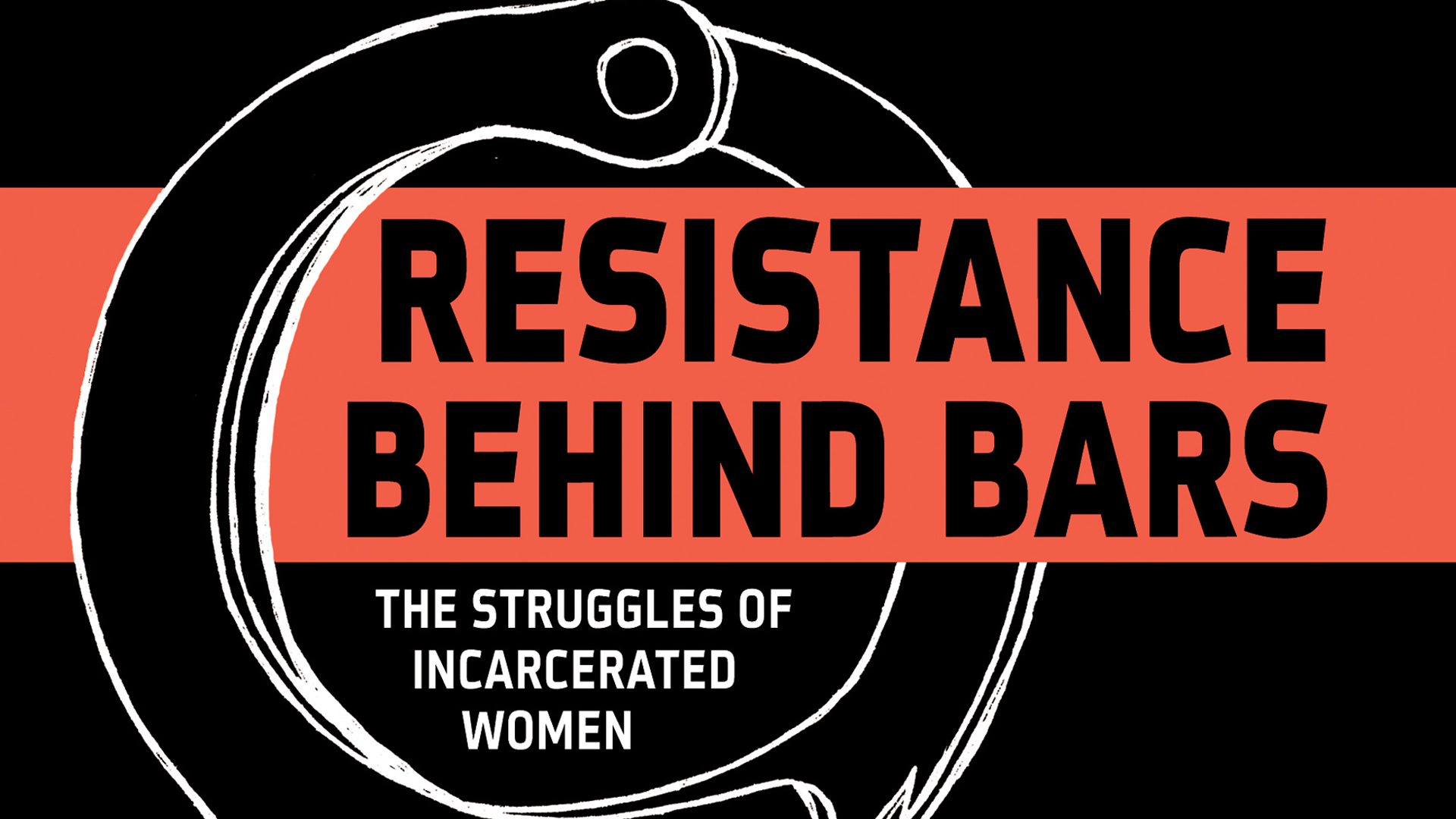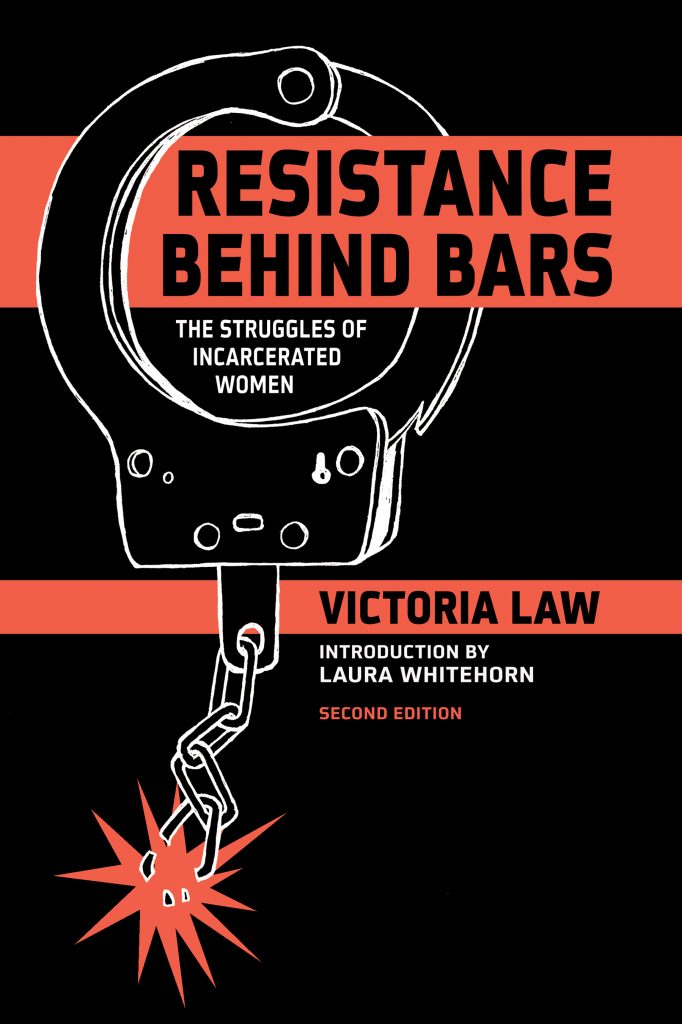By Joan Brunwasser
OpEdNews
February 11, 2010
In late December, I interviewed Ramsey Kanaan of PM Press. In the process, I perused their catalog. One of the books that caught my eye was Victoria Law’s, which I subsequently read. It was equally fascinating and harrowing. Welcome to OpEdNews, Vikki. Please tell our readers how you came to write Resistance Behind Bars: The Struggles of Incarcerated Women?
In college, I had spent a semester researching post-Attica prisoner organizing and resistance. At the end of that semester, I looked back at what I had found and realized that every instance, except for one, was about male prisoners. I talked this over with my professor and spent the next semester exploring incarcerated women’s issues and their ways of resisting or challenging their conditions of confinement. I also explored why their actions weren’t as well-documented (or remembered) as their male counterparts.
To do this, I set aside all preconceived notions of what I thought of when I thought of prisoner organizing and started reading books and articles specifically about women in prison. I found a LOT of literature that covered specifically female issues like motherhood and pregnancy behind bars. Issues of parenting (and, of course, pregnancy) are often not even mentioned in books and articles about male prisoner organizing leading people who are looking for instances of prisoner resistance to ignore how people in prison organize around parenting and family issues. Battering and abuse is another issue that comes up in literature about incarcerated women, but again, since that’s not an issue that we see impacting men going to prison, it isn’t perceived as as a “prison issue.”
I
also scoured the news (and alternative media, mostly prison-related
zines) for mentions of actions by incarcerated women. Once I found that
someone had done something (filed a lawsuit, complained to the press,
launched a hunger strike, etc), I used the websites of either that state
prison system or the federal Bureau of Prisons to find the woman’s
contact information and sent her a letter explaining who I was and what I
was researching. I asked if she would be willing to share her stories
and experiences with me.
Not wanting to take without giving back, I offered what I could: I offered to look up lawsuits for them and send them copies of court decisions; I offered to look up other resources for them; I offered to send them books via the Books Through Bars program that I helped start here in NYC; I sent stamps so that they could not only respond to me, but also write letters to other groups or people; in one cases, I offered to call the woman’s children when she was unable to call.
I got a lot of reading, researching and writing done in those four months. That one semester really opened my eyes about the gendered perceptions that we, as a society, have about prisons as well as about what resistance looks like (both inside prison walls and outside).
I also want to add that a huge part of my ability to get so much research and writing done in four months was because I had had a baby daughter 6 weeks before the semester started; being stuck inside during the winter with a newborn gave me a LOT of time to read, respond to letters, contemplate ideas and issues (mostly while nursing), and revise draft after draft. I doubt I would have had the same ability to concentrate (and write) if I had still been as a childfree person rushing off from one political event to another at various hours of the day and night or if my daughter had been older, more mobile and needing more direct attention.
That was the start of what became Resistance Behind Bars. After the semester ended, I kept in contact with most of the women and continued to add their stories and experiences to my paper. I sent the paper to a man named Anthony Rayson, who publishes many many zines of prison writings. He, in turn, photocopied the paper and brought it with him to a talk he gave about prisoner organizing; someone at his talk took the paper and turned it into a pamphlet and started distributing it.
I continued to add stories and facts to my original paper as I came across them. I also started taking sections of my paper, like the part about women’s organizing for better health care and women creating their own media, and sent them to activist publications like Clamor Magazine, Punk Planet and off our backs.
Almost 8 years after I had first started exploring this subject, I met Ramsey Kanaan at PM Press. He was interested in publishing my work as a book. I wrote to the women who had shared their stories with me and told them about the opportunity to spread their experiences to wider audiences. All of them agreed to have their stories published, although a couple of them asked that their real names not be used.
Following the example of a few other articles by activist groups on the outside written about women in prison, I decided that I would share my drafts with the women whom I was writing about. Every woman got multiple drafts of the chapter(s) that her stories and experiences appeared in. Each woman had the opportunity to add, correct, update or remove anything that pertained to her.
That must have been incredibly time-consuming.
In a couple of instances, women also commented on some of the material and information in that chapter. For instance, when I sent the chapter on education to RJ, she commented extensively on a study about higher education in women’s prisons, pointing out that the study made prison seem like an idealized environment for women to pursue a higher education and highlighting some of the harsher daily realities for incarcerated students.
I also had incredible help from several people on the outside who read my entire manuscript at various stages, gave feedback and asked questions that forced me to explore the issues further.
And, being the mother of a small child (although she might disagree with the characterization of herself as “small”), I want to stress that a book-length work would not have been possible without the huge amount of support I received from both my friends and the people with whom I organize. I realize that not all mothers get this type of support, although they should, and that I’m extremely fortunate to have such a wonderful support system.
That’s the long answer. When I told her about the interview and this question, my daughter, now age 9, suggested a shorter response: “There are some things in the world that I disagree with. Also, many people don’t think about women when they think about prisons and so I wanted to write a book that brought attention to them.”
If
we look at the imprisoned as being at the bottom of the totem pole,
women prisoners are, in general, even lower. Women face many
disadvantages that men do not. Could you talk about that a bit, Vikki?
When prisons were first built in the U.S., they were designed for men. Women were not thought about when prisons were designed. When women were incarcerated, they were stuck in the attics or basements of the penitentiaries. Sometimes they were even stuck in the cells next to male prisoners (and then were blamed for any disturbance that their presence caused among the male prison population). They were given less access to the few programs and activities that the men were allowed, such as access to the chapel, medical care or to go outdoors. They were also in danger of sexual abuse from the male prison staff.
Keeping that in mind, we can see how, even centuries later, incarceration is still gendered as male and thus prisons are designed with men in mind. For instance, prison health care is geared towards men. This is not to say that men in prison have excellent medical care, mind you. Health care in prison is atrocious for all genders, but it also does not take into account the specific health concerns of women, such as menstruation, pregnancy, breast cancer, cervical cancer, etc. (I also want to add that the prison health care system takes into account even less the concerns of transgendered and transsexual prisoners)
Another aspect that affects women much more often than it affects men is parenting. This reflects not only the way prisons were originally designed but the way our society, as a whole, is gendered so that the bulk of parenting falls upon mothers. The majority of people in prison are parents, but when a father goes to prison, often times a female relative (such as a wife, girlfriend, mother or sister) will take on raising his child(ren). When a mother goes to prison, she’s much more likely to already be a single parent. Lacking the same support as her male counterpart, her children are five times more likely to end up in the foster care system.
This becomes particularly pernicious because, under the 1997 federal Adoption and Safe Families Act (or ASfA), if a child is in foster care for fifteen of the last twenty-two months, the child welfare agency is required to file a petition to terminate parental rights. Only 2 states have made exceptions for incarcerated parents.
However, most people don’t think of parenting when they think about prison. Even incarcerated fathers don’t necessarily recognize parenting as a prison issue. Last year, I did a talk at a reentry program for formerly incarcerated men. Half of the men were fathers; all of them had their kids cared for by their wives or other relatives while they had been locked up. None of them had had their children placed in the foster care system because there was no one willing to care for them while their father was incarcerated. The men were startled to learn about the 15-month time line of ASFA because their children were taken care of and so ASFA didn’t impact them.
Yet another aspect that disproportionately affects women in prison yet is ignored is abuse. Over half of women in local jails, state and federal prisons report having experienced past physical, sexual and/or emotional abuse. Keep in mind that people tend to underreport experiences of abuse, so that number is, in reality, much higher.
A Bureau of Justice report found that women in prison are three times more likely to have been physically and/or sexually abused before incarceration than men. However, prisons not only lack the resources to help support women in working through past abuse, but often perpetuate the abuse. Under the 1964 Civil Rights Act, gender cannot be considered when employing guards. This means that women have the right to work in male prisons and men have the right to work in female prisons. In many, many cases, this has led to sexual abuse of women prisoners by male staff members, who often have the right to be in sensitive areas such as the toilet area, the shower area, the housing units where women dress, undress and sleep, etc.
I could go on and on about how women face additional problems and dangers than their male counterparts in prison, but I’ll stop with these examples. I do want to emphasize though that I am not pointing out these disadvantages to call for more “women-friendly” prisons. The construction of the first women’s prison units were the result of well-intentioned reformers’ horror at the abuses and depravities that women suffered when they were housed in male prisons.
However, when the first female-only prison unit was built in Illinois in 1859, the number of women being sent to prison tripled because judges became less reluctant to send women to the hellholes that were prison.
More recently, in 2006, the California Department of Corrections and Rehabilitation (CDCR) identified 4500 women who did not need to be imprisoned and instead would be better off in their home communities getting drug treatment, job training, etc. Instead of putting together a plan to release them, however, CDCR proposed building 4500 new beds in what they called Female Rehabilitative Community Corrections Centers, essentially mini-prisons, in the urban areas where many of these women had lived before arrest **without** closing any of the beds in the existing women’s prisons. In essence, their recommendation means that 4500 more women could be sentenced to prisons. The existence of these mini-prisons also meant that, lacking many of these treatment programs on the outside, judges would be more likely to sentence women to these Corrections Centers to access these programs.
However, the bill that was finally passed in 2007, AB76, did not address the root causes of rising female incarceration: mandatory sentencing, racial profiling, poverty and the feminization of poverty, or the lack of support systems for women leaving prison. Instead of focusing on reforming the prison system to make it more habitable for women, I’m a firm believer that we should shift these resources back into the communities to address the reasons why women are sent to prison in the first place.
Okay, Vikki. Let’s pause here. When we return, you can tell our readers how our prison system mitigates against families staying together and how prisoners’ children can be used as pawns to control their mothers’ behavior.
Welcome back for the second installment of my interview with Victoria Law, author of Resistance Behind Bars. Another factor in the women’s virtual invisibility in prison is the way the institution itself stifles any complaints or dissent. If I recall correctly, filing complaints is considered on a par with inciting a riot, bringing retribution on those who dare to stand up to the system.
This even extends to non-threatening educational programs where inmates strive to better themselves. These efforts are often unceremoniously shut down. Why doesn’t the system want women to become literate and aware of their rights? And what is the basic purpose of incarceration anyway? Is it punishment or rehabilitation?
If prisons were meant to rehabilitate, then the system should have no problems whatsoever with women’s efforts to become literate, educated and aware of their rights. However, despite the mission statements of various departments of corrections across the country, prisons are not meant to rehabilitate those held within.
Prisons are and have been a means of social control. In the post Civil War South, new laws were passed to strip newly freed slaves of their rights under the slightest pretext. Under the Black Codes, people could be arrested and jailed for being outside after a certain hour, absence from work or possession of a firearm, but only if they were Black. The passing of the Black Codes radically changed the color of prisons in the South–prior to the Civil War, when slavery was the form of social control for Black people, the majority of those in prison were White. After the Civil War, incarceration became the means to strip newly freed Blacks of their freedom and their rights.
In the late nineteenth and early twentieth century, the rise of female independence caused an increase in women’s incarceration for actions such as being drunk, engaging in pre- or extramarital sex, contracting a venereal disease, or “keeping bad company.” Like the Black Codes in the South, these actions were only criminalized when they were performed by women; men could do all of these and not be penalized.
These
days, laws like Three Strikes and other mandatory sentencing
legislation as well as racial profiling by police across the country
disproportionately target people in poor communities and communities of
color. Again, we’re seeing incarceration being used as a form of social
control against those who are poor and of color. For instance, in 2000,
the census found that 75% of New York State prisoners came from 7
neighborhoods in New York City.
These neighborhoods were poor communities of color where there were few resources and opportunities for the residents. Incarceration hasn’t made those neighborhoods “safer” nor has it rehabilitated those who have been imprisoned so that they can return to their communities and thrive; instead, it’s disrupted and destroyed families in these neighborhoods and made it even more difficult for people who were already at the bottom of the socioeconomic ladder to survive and thrive. Those who have been to prison face not only the same lack of resources and opportunities, but now have a criminal record which prevents them from getting certain jobs, qualifying for certain housing or social safety nets (for example, the 1996 welfare “reform” banned people with drug felonies for life. Similar legislation banned them from receiving governmental financial aid for college), etc.
It’s also not a coincidence that mass incarceration began as the civil rights movement and various liberation struggles were gaining momentum in the United States. Government officials linked the growing civil unrest with crime and used arrest and incarceration to remove people from their communities *before* they could organize against social conditions and demand their rights.
So to get back to your question, if the system were set up to rehabilitate people, it would not be threatened by women (or people) becoming literate and educated and learning about their rights. It would actually encourage these actions.
Again though, the basic purpose of incarceration is not rehabilitation, but social control, so to have people learn about their rights and then begin challenging the injustices and oppressions around them is a threat.
And, following this thread, it would seem that the prison system would want the family to remain strong and united so that women, upon being freed, would more easily reintegrate into their lives and communities. If so, the way prisons seem to run in the opposite direction. As a mother, this aspect of our system bothers me the most. Can you talk a bit, Vikki, about how the system uses women prisoners’ families and access to them to keep them in line? How many kids under 18 have a mother in prison? And what happens to these kids while their mothers are incarcerated?
In 2007, approximate 147,400 children under the age of 18 had a mother behind bars. Over 2/3 of all women in prison reported having a child under the age of 18. Keep in mind again that with self-reporting, the actual numbers tend to be higher. If there is someone else who can take care of her children when she is arrested, a mother may very well not report having minor children to the police or other authorities for fear of child welfare officials taking away her children.
But also keep in mind that about half of all incarcerated mothers were single mothers before being arrested and, given that those who go to prison tend to be those with the least amount of resources and opportunities, they have less of a support network to rely upon to help care for (and keep in contact with) their children.
A 2007 government study of incarcerated parents found that 37% of incarcerated mothers reported that their children were living with the father. In contrast, 89% of incarcerated fathers reported that their kids were living with the mother. An incarcerated mother’s children are five times more likely to end up in foster care than an incarcerated father’s children. And, as I pointed out earlier, this becomes particularly pernicious because of the federal Adoption and Safe Families Act’s (ASFA’s) stringent timeline. (Here’s another fact that will trouble you: the 15 month timeline was decided upon as a political compromise; it was not based on any child development theory or practice. When ASFA was first negotiated by Congress, one party wanted the timeline to be 12 months and the other wanted it to be 18 months. So hundreds of children are legally losing their parents based on a timeline that was a political compromise in Congress.)
The children of incarcerated mothers who don’t end up in foster care are often cared for by other family members, like their grandparents.
For those who think that this is not such a bad thing, remember that people who go to prison are often at the bottom of the socioeconomic ladder and that the families and communities from which they come are as well. That means that grandparents may already be struggling financially (and perhaps health-wise as well). Given that women’s prisons tend to be built far from the urban communities they called home before incarceration, it is a strain for caregivers to take children to visit their mothers. One study found that 60% of incarcerated mothers are imprisoned at least 100 miles away from their home communities. Approximately half of all incarcerated mothers in state and federal prisons report never having had a visit with their child(ren).
Keeping in contact by phone is also a huge challenge, one that can be almost impossible for those with limited resources. In Colorado, for example, a 20-minute phone call costs $3.80 in state or $4.60 for an out-of-state phone call. Again, given that family members and caregivers often come from the same socioeconomic circumstances as the women in prison, these costs can be prohibitive.
Even when a family has the means to visit their loved one in prison, they are subject to the whims and caprices of the prison staff on duty. A woman in Colorado recently sent me a few examples of how prison officials can arbitrarily withhold visits:
- Last month, my roommate was expecting a visit from her family, including her four-year-old daughter. Visits begin at 1 pm, but she was not called until 3:30 pm. She learned that her family had arrived at 1:45, but the guard at the front desk told them that the visiting room was full and that they would have to leave and return later if they wanted to visit. He told them not to come back until 3 pm and that they could not wait in the parking lot or sit in their car.
Later, another woman, who had been in a visit that day, heard about this, told her that there had been an empty table next to hers during the entire afternoon. Of course, there was no way for my roommate’s family to know this in order to question being turned away. My roommate knew even less; all she could do was wait and worry.
- Last weekend, my friend was to have two days of visits from her mother and daughter, who had driven 1200 miles to see her. On the second day, her mom arrived wearing the exact same shirt as on the previous day. The officer on this day did not permit her mother to visit until she left and bought a new shirt, despite the fact that it had not been a problem 24 hours earlier.
All
the while, my friend watched from the window as her family pulled into
the parking lot, walked in, then she watched them leave without knowing
what was going on. She sat on the stairs, devastated and crying for what
she believed was a lost visit until her family returned and she was
paged one hour later. One hour is precious time, especially when our
families drive across the country to visit.
Now that I’ve given you
some context as to how hard it is for mothers to stay in contact with
their children and families, I’ll answer your question about the system
using women’s access to families to keep them in line.
As you can see from the above examples, prison staff can arbitrarily impede a woman’s ability to visit with her family, even when the woman has not been challenging prison conditions. Prison administrators also use visiting to punish those who challenge existing prison conditions. A woman incarcerated in New York noted that prison staff would actually turn away family members who were visiting women who had been seen as problematic.
Other times, prison officials have acted to strip a mother of all ability to see her child(ren). After one woman successfully sued the Michigan Department of Corrections for sexual abuse, guards targeted her cell and belongings for frequent searches. In the eight months after MDOC adopted a policy banning visits for prisoners with repeated substance abuse violations, the woman, who had never tested positive for any drug during her eight years of incarceration, received four tickets for substance abuse. “I received two substance abuse tickets in one day,” she recalled. “One was for borrowing Motrin (Ibuprofen) from a prisoner for cramps. I also had Iron pills that had been prescribed to me that were a day over the expiration date.” These tickets prevented her from having her daughter visit her.
A woman in the federal system had been speaking out against prison conditions in the facility where she was housed. She was finally eligible for a furlough, which was a chance to leave the prison for 36 hours and visit her family at home. The prison’s unit manager delayed approving her furlough papers, stating, “It was concluded that you may be a threat because you might contact the media and manipulate the system.”
She did eventually receive her furlough and wrote, “Here I am enjoying my sons in my arms and wondering if it is worth it to put my next 7 day furlough and half way house at risk, if I continue writing from prison.” However, she concluded, “But my dear friends, I feel that if I do not write to you I am as good as dead. The truth is important to me, and such it should be told.”
I give you these examples to illustrate the all-too-real threat that incarcerated mothers face when deciding whether to speak out or otherwise challenge prison conditions. However, despite these threats, mothers (and other women) have spoken out against, challenged and resisted unjust prison conditions.
This breaks my heart. Would I have the strength to persevere in the face of this? I wonder. Let’s break here. When we return for the final portion of our interview, Vikki will tell interested readers how we can help women in American prisons.
Welcome back for the conclusion of my interview with Victoria Law. You’ve shown us how appalling prison conditions are, particularly for women trying to keep their families together somehow. All in all, a pretty bleak picture. What’s the bottom line here, Vikki? What can those of us on the outside do to raise awareness of what’s going on inside? And can it help? Or does it just put those inside more at risk?
Of course it can help!
When I was doing research for my book, every woman whom I contacted thought that the issues and injustices of incarceration needed to be brought into the public conversation. Not a single woman expressed a fear that increased public attention towards prison conditions would put them more at risk. On the contrary, almost all of them felt that increased public attention (and pressure) would force prison administrators and staff to improve conditions, even if it were only slight improvements.
Here’s
an example of how outside awareness and pressure resulted in an
improvement for the women inside: In 1976, the California Institute for
Women established an “Alternative Program Unit” or closed-custody
behavior modification unit for women deemed “disruptive” (those seen as
leaders, lesbians or disobedient).
Women inside the prison organized against this unit and people outside organized a rally where ex-prisoners spoke out about this unit. Media coverage of the rally generated public outrage over the discriminatory criteria by which women were selected for the behavior modification unit. The ensuing public pressure and the disapproval of influential state officials (who no doubt were also pressured by their constituents) led the prison to close the unit soon after the rally. Women who had been confined in this “prison within a prison” were transferred back to general population.
More recently, when the California Department of Corrections proposed building 4500 new beds in “Female Rehabilitative Community Corrections Centers” in 2006, over one thousand women incarcerated in California signed a petition voicing their protests against the construction of these new beds and sent it to California Governor Schwarzenegger while advocates on the outside held rallies, filed a lawsuit, lobbied elected officials and raised public awareness (and outrage) about the issue.
I asked the women inside how they felt that people on the outside could help to both raise awareness about what’s going on inside and support women in prison without inadvertently making the prison system bigger or stronger (as I talked about earlier with calls to reform the women’s prison system leading to an increase in sentencing and an expansion of the prison system). These are their suggestions:
- Make contact with women in prison. “Visits, phone calls, and letter writing are essential. Only with a firm foundation, a strong foundation, can we together be able to build a greater movement,” says a woman incarcerated in Florida.
- Speak out about these issues, especially when they intersect with issues that are considered “non-prison” issues, such as education, employment, racism, etc.
- Send literature and news from the outside to help keep women connected with the rest of the world.
- Write articles about women prisoners’ issues, experiences, and actions, or publish their articles.
- Peer education groups need up-to-date information on health issues and treatments! They need outside people who are willing to provide services not available (but much needed) within the prison.
- If you are connected to a university or other educational institution, look into setting up a women’s studies course or other program within a women’s prison that helps articulate and challenge the dominant ways of thinking and the power structure. In Oklahoma and other states, there is already a structure set up for outside organizations to come in. Thus far, these structures have primarily been utilized by Christian groups seeking converts. As one woman pointed out, “People in prison soak up information. Anything new and different is absorbed–coveted even. Books, pamphlets, etc. And, if you tell me that you will give me a certificate when I complete an assignment, I will do it–just so that certificate can go in my parole file. So, sell it–and make it a novelty. Only come to the same unit once a quarter, etc”Then while you have their attention, teach the lesson. Empower the women. Help them pick up and stand them on their feet. The men’s units have this all over the place, especially from the religious organizations.”

prison art by R Sieber
Tell us about the book program you set up for prisoners. How does it, and similar programs, work?
In 1996, I helped set up Books Through Bars–NYC, a program that sends free books to prisoners across the country. There were already several other books-to-prisoners programs across the country and this project was partially inspired (and assisted by) the Books Through Bars group in Philadelphia.
Books Through Bars–NYC was originally a joint project between two explicitly anarchist groups (Blackout Books and Nightcrawlers Anarchist Black Cross). It was a project with an explicitly political purpose of providing political and thought-provoking literature that people in prison would not be able to get otherwise. Since then, we’ve expanded our focus to include sending educational books (such as writing how-tos and math and science books) as well as history books and non-mass market fiction.
The way Books Through Bars NYC (and other groups like it) works is this:
A person in prison finds out about the group and writes a letter requesting books. Sometimes the person requests specific titles, such as The Autobiography of Malcolm X or Webster’s dictionary. (Dictionaries, by the way, are our most popular request) Sometimes the person requests the subjects that she or he is interested in, such as African-American history, Aztec history, Chicano/a history, etc. Sometimes the person simply wants reading material to pass the time.
We get the letter and, during one of our thrice-weekly packing sessions, a volunteer scours our shelves of donated books to find a match (or, more often, an approximate match). We then send the person the book(s).
We receive over 400 requests each month, so multiply that process many many times over.
Being an all-volunteer, grassroots organization, Books Through Bars relies on donations for both books and postage money. We receive a modest grant from a family foundation that covers about half a year’s worth of postage expenses. The rest of the money we raise through benefit fundraisers and donations from individuals. We are also fortunate to be working in the basement of an organization that recognizes the importance of our work and thus does not charge us rent.
Oftentimes, volunteers do not include a personal note with the book(s) being sent. However, on a few occasions, a letter may move one of the volunteers to begin a personal correspondence. I developed relationships with several women who had originally written to Books Through Bars requesting books on HIV/AIDS for a peer educator program or books on radical politics. Later, these women contributed their experiences and insights to Resistance Behind Bars. I also developed a relationship with the woman whose illustration graces the cover of my book; she had originally written to Books Through Bars requesting radical political literature. Her request caught my attention and so, after sending her a package of books, I wrote her a letter and that’s how our correspondence began.
Even without the personal note or striking up of a relationship, the group sends books to thousands of people behind bars, most of whom would not receive books any other way. (Most state prison systems are not required to have a library or access to reading material for prisoners. Even when a prison does have a library, it is not necessarily accessible to all of the people inside. If a person’s prison job conflicts with library hours, that person will never be able to use the library. If a person is in solitary confinement, he/she is often not allowed access to the library.)
What a terrific service this provides. Okay, I think this about wraps it up, Vikki. Is there anything you’d like to add?
Whew! I think that’s all.
Well, thanks so much for taking the time to talk with me. You have tackled an unpleasant but important topic. Women in our prison system have been largely invisible. With the publication of Resistance Behind Bars, perhaps that’s about to change. Thank you, Vikki, and good luck with your book.







